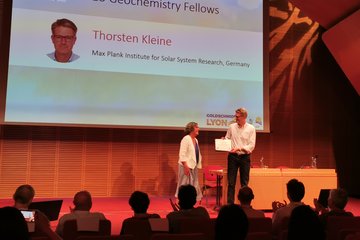Alle Typen
121.
Zeitschriftenartikel
Plasma flows guided by strong magnetic fields in the solar corona. Astrophysical Journal 685, S. 1262 - 1269 (2008)
122.
Zeitschriftenartikel
Nonlinear Force-Free Modeling of Coronal Magnetic Fields. II. Modeling a Filament Arcade and Simulated Chromospheric and Photospheric Vector Fields. Solar Physics 247, S. 269 - 299 (2008)
123.
Zeitschriftenartikel
A first step in reconstructing the solar corona self-consistently with a magnetohydrostatic model during solar activity minimum. Astronomy and Astrophysics 481, S. 827 - 834 (2008)
124.
Zeitschriftenartikel
Nonlinear force-free field modeling of a solar active region around the time of a major flare and coronal mass ejection. Astrophysical Journal 675, S. 1637 - 1644 (2008)
125.
Zeitschriftenartikel
Evolution of the flaring active region NOAA 10540 as a sequence of nonlinear force-free field extrapolations. Astronomy and Astrophysics 484, S. 495 - 502 (2008)
126.
Zeitschriftenartikel
First nonlinear force-free field extrapolations of SOLIS/VSM data. Astronomy and Astrophysics 488, S. L71 - L74 (2008)
127.
Zeitschriftenartikel
Study of Magnetic Channel Structure in Active Region 10930. Astrophysical Journal 687, S. 658 - 667 (2008)
128.
Zeitschriftenartikel
Nonlinear force-free modeling of the solar coronal magnetic field. Journal Geophysical Research 113, A03S02 (2008)
129.
Zeitschriftenartikel
Can We Improve the Preprocessing of Photospheric Vector Magnetograms by the Inclusion of Chromospheric Observations? Solar Physics 247, S. 249 - 267 (2008)
130.
Zeitschriftenartikel
First stereoscopic coronal loop reconstructions from STEREO/SECCHI images. Astrophysical Journal 671, S. L205 - L208 (2007)
131.
Zeitschriftenartikel
Magnetic Stereoscopy of Coronal Loops in NOAA 8891. Solar Physics 241, S. 235 - 249 (2007)
132.
Zeitschriftenartikel
Segmentation of Loops from Coronal EUV Images. Solar Physics 248, S. 379 - 393 (2007)
133.
Zeitschriftenartikel
Evolution of a Coronal Loop System. Solar Physics 240, S. 37 - 48 (2007)
134.
Zeitschriftenartikel
Computing Nonlinear Force-Free Coronal Magnetic Fields in Spherical Geometry. Solar Physics 240, S. 227 - 239 (2007)
135.
Zeitschriftenartikel
Optimization approach for the computation of magnetohydrostatic coronal equilibria in spherical geometry. Astronomy and Astrophysics 475, S. 701 - 706 (2007)
136.
Zeitschriftenartikel
Nonlinear force-free magnetic field extrapolations: comparisonof the Grad-Rubin and Wheatland-Sturrock-Roumeliotis algorithm. Solar Physics 235, S. 201 - 221 (2006)
137.
Zeitschriftenartikel
Nonlinear force-free modeling of coronal magnetic fields Part I: A quantitative comparison of methods. Solar Physics 235, S. 161 - 190 (2006)
138.
Zeitschriftenartikel
Magnetic Stereoscopy. Solar Physics 236, S. 25 - 40 (2006)
139.
Zeitschriftenartikel
Testing non-linear force-free coronal magnetic field extrapolations with the Titov-Démoulin equilibrium. Astronomy and Astrophysics 453, S. 737 - 741 (2006)
140.
Zeitschriftenartikel
Preprocessing of vector magnetograph data for a nonlinear force-free magnetic field reconstruction. Solar Physics 233, S. 215 - 232 (2006)











